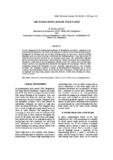| dc.description.abstract | In rural settlements of the predominant floodplains of Bangladeshi, an intrinsic component is the extended family homestead. The layout of the homestead is defined by the courtyard, formed by the arrangement of dwelling units and ancillary building around an open space. Specific building typologies prevail, in terms of design, construction and building materials. Some typical types of courtyard can be observed, but there are also variations to these types. The courtyard has important physical and functional characteristics derived from the climatic requirements and living patterns. Nonetheless, particularly in this predominantly Muslim society, the cultural aspect of respecting women’s privacy is an important factor behind the development of this archetype. However, other communities living in the floodplains also have courtyards, suggesting that it is also a regional archetype. The archetypal courtyard is subject to transformation or elimination due to social, economic and environmental changes. If this trend becomes widespread, it would signal the loss of an important and long-lasting regional expression that has resulted from blending of culture, climate and nature. | en_US |

